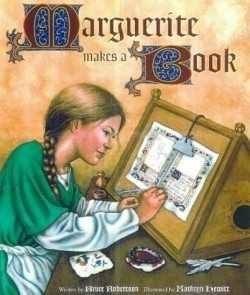Marguerite Makes a Book
When Margurite’s beloved Papa Jacques, “the oldest and most famous book painter in all of Paris,” is having difficulty completing an illuminated manuscript for his patron, the Lady Isabelle, Marguerite offers to help. Her father says that it is his paintings his patron wants—not those of a young girl—then invites Marguerite to accompany him on his errands.
When they leave their home near the Notre Dame cathedral, father and daughter step out into illustrations of a Paris in the 1400s that are as intriguing as an advent calendar and as decorative as an illuminated manuscript. At times the award-winning illustrator, Hewitt, perches the reader above the city, looking down on church spires and humorous gargoyles. Or she shows a house with its sides removed to reveal family activities within. Her cobble streets offer details of period commerce and music. They are pictures to linger over and savor with a child, as
if spending a day in a museum gallery.
After her father has a nasty fall and breaks his glasses, Marguerite decides to take matters into her own hands and begins by completing her father’s errands. His list takes her to the country for parchment skins, to the market for feathers for his pens and eggs to make paint. She visits the apothecary for “dried safron flowers, madder root, a cake of vermilion, some wax, pine pitch, and some lapis lazuli stone” for the brilliant colors.
When she has her materials, Margurite draws “bouquet after bouquet of blooming flowers and nesting birds in the margins of the manuscript.” The double centerfold takes the reader step-by-step through the mixing of colors, and then she begins to paint. She makes her own illuminations and completes her father’s designs just as Lady Isabelle arrives.
Many pages are elegantly bordered with gold and display exquisite designs—some whimsical—resembling illuminated manuscripts of the 1400s. The faces of people in the various illustrations are evocative of the fifteenth century interest in portraits, including those of patrons.
The book contains a glossary, simplified maps of Paris for a sense of place and a note that explains how the J. Paul Getty Museum’s rare collection of European illustrated manuscripts inspired the book.
Robertson is professor of art history at the University of California, Santa Barbara, and author of two other books. Hewitt has illustrated numerous children’s books. Their book would please Lady Isabelle. Age 8 and up.
Disclosure: This article is not an endorsement, but a review. The publisher of this book provided free copies of the book to have their book reviewed by a professional reviewer. No fee was paid by the publisher for this review. Foreword Reviews only recommends books that we love. Foreword Magazine, Inc. is disclosing this in accordance with the Federal Trade Commission’s 16 CFR, Part 255.

